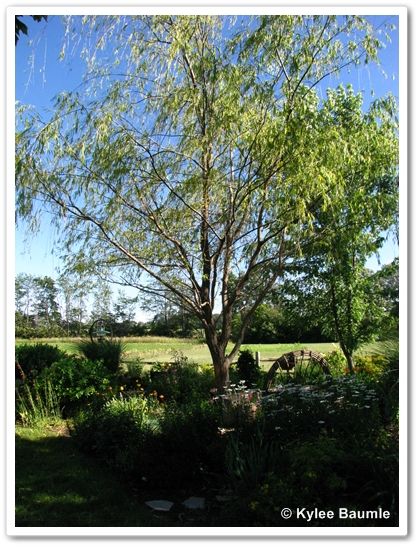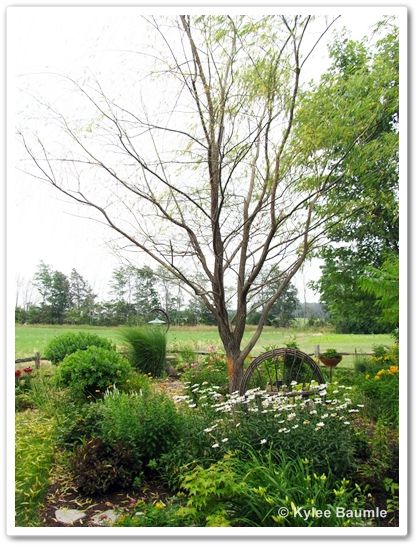 |
| 6.28.11 |
When Chris Tidrick and his wife Mindy were guests in our home at the beginning of this month, we were walking through the garden and I noticed some white foam exuding from the trunk of the willow. The bark was dark around the foam and it just looked wet.
 |
| Photo by Christopher Tidrick |
 Also noticed were some warty growths in abundance on the trunk and on major branches. Giving those a scrape showed green underneath.
Also noticed were some warty growths in abundance on the trunk and on major branches. Giving those a scrape showed green underneath.Google can be your friend, but when the news isn't good, it doesn't feel that way. Between several of us searching for an answer to the willow's problem, and information that Chris later forwarded to me from a tree expert , it would appear that our willow has slime flux disease, or bacterial wetwood disease. This is a disease that affects the cambium and causes rot.
It's common in willows and several other types of trees and may be what killed the sister tree to this one a few years ago. It simply died one year and we really never knew why, but assumed it was the drought we'd suffered the summer before. Both trees were planted when we lost yet another weeping willow to a storm one summer when winds uprooted it.
Doing some more reading on bacterial wetwood today, I found that doing nothing would almost surely mean the tree would eventually die from the disease. But by removing the infected area and treating it with rubbing alcohol or a 10% bleach solution could give it a chance.
So, Romie and I got what we needed and proceeded to remove the bark until we encountered green cambium (the layer under the bark). We removed quite a bit, seeing bits of green here and there, but never really running into consistently healthy tissue. We stopped, tried to make the surgical wound as smooth as possible and soaked it with the bleach solution.
Now we wait and see, but I'm not hopeful, since the tree didn't leaf out like it normally does and it's been dropping leaves (most of them yellowed) like crazy. I think it's a case of too little too late and that its days are numbered, and Max's Garden will be undergoing a major change in appearance soon.
 |
| 7.1.11 |
There are other trees in the garden - all maples - so it isn't that we'd need another tree there. And I really wouldn't have to move too many plants to other shady areas (a few Tricyrtis, a couple of Hostas, and a Ligularia), but it's hard to imagine this garden without the willow. The garden was designed around it.
This hasn't been a good year for trees at Our Little Acre. We also lost our Japanese Fantail Willow 'Sekka'. And the fourth tulip poplar we've tried to grow is gone, too. It leafed out just fine this spring (it's third here), then promptly died. I think we won't plant any more willows or tulip poplars.


















 "Bejeweled"
"Bejeweled"



8 comments:
Always sad to lose a member of our garden families. :(
I'm so sorry, Kylee. I feel your pain. I HATE when I lose a tree (or a neighbor's tree, for that matter). They become such a part of our garden, and our lives, don't they? Out here in California we have the deadly Oak Root Fungus which is a silent killer of so many plants. And it's virtually impossible to remove from the soil once its there. I've suffered many losses in my own garden, watching majestic trees get the familiar tell-tale wilt one year and die the next. But as my always-positive friend down the street always says "it's just another planting opportunity".....but still....
For some reason losing a tree seems so much worse to me than losing a plant. Sorry to hear of your loss. I too have had terrible luck with trees this year. I lost a white and a pind dogwood. Pluse the white lilac is in the process of dieing. The wild fluxuations of weather, drought last year then flood this spring, took their toll.
We have this problem with the red maple in the front lawn. I was going to remove the tree anyways so I'm not sad like you. It's too bad you're losing this tree that you love, always rough to lose a tree that you love (we lost a cherry last year)!
I wonder if you could add some tea tree oil or apple cider vinegar to the wound, or maybe rub it with garlic?
I chuckled when you said you can't grow a tulip poplar as they're my worst weed here in the garden. I find myself pulling tulip tree seedlings on a daily basis by the hundreds. Perhaps I can send you some seeds to some native Ohio tulip trees.
Kylee - sorry you're losing your beautiful tree. Willows are among my favorites - but of course we can't have them here. Many of my trees are stressed from the drought. We are giving them extra long, slow waterings, but this is the worst drought since the 1800s. My giant Burr Oak is raising its roots above the grass. I hope you can put something else special in Max's garden - a tribute to your willows.
Oh dear. This is sad news indeed. It's always awful to have to see a tree come down, let alone one as beautiful as your willow and one around which a whole garden was designed.
I hope you will embrace the challenge of finding something new and equally special to take the place of the tree and that your garden won't be too unhappy with the disruption and the change.
Good luck with the new direction of Max's garden, whatever that ends up being! Perhaps you can save part of the willow to make a planter or something, to keep a piece of it with you and its memory alive.
I definitely feel your pain. We have a corkscrew willow that hasn't looked great for a few years and now our redbud is going through some obvious stress. It is so painful to lose trees.
I had that happen to a young willow one year, but it recovered. It looked wonderful and healthy until this winter. The ice storm did more damage to it- and it looks like it will eventually recover from that....
Post a Comment